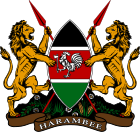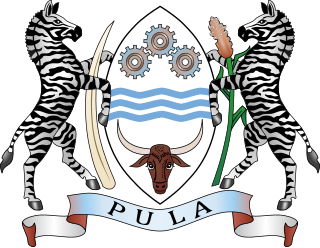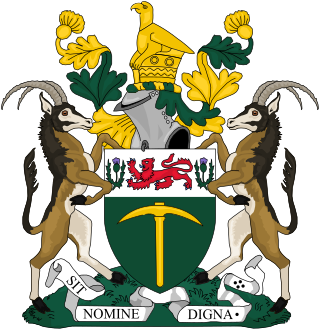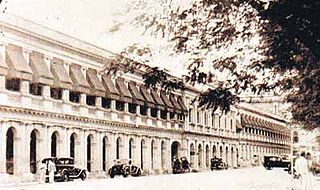 |
|---|
|
Economic schemes |
General elections were held in Kenya in May 1948.
 |
|---|
General elections were held in Kenya in May 1948.
The seats in the Legislative Council were distributed according to a race-based franchise. Eleven Europeans were elected from single-member constituencies defined as Part A; five Indians (two of which were required to be Muslims) were elected from three Part B constituencies, and one Arab was elected from a single nationwide Part C constituency. Four Africans and nine Europeans were nominated members.
| Constituency | Candidate | Votes | % | Notes |
|---|---|---|---|---|
| European seats | ||||
| Aberdare (19 May) | Gerald Hopkins | 299 | 58.4 | Elected |
| Clive Wilfrid Salter | 152 | 29.7 | ||
| Arthur Sutcliffe | 61 | 11.9 | ||
| Coast | Shirley Victor Cooke | Unopposed | Re-elected | |
| Kiambu | Wilfrid Havelock | Unopposed | Re-elected | |
| Mombasa | George Nicol | Unopposed | Re-elected | |
| Nairobi North (14 May) | Ernest Vasey | 391 | 61.2 | Re-elected |
| Stanley Ghersie | 248 | 38.8 | ||
| Nairobi South (12 May) | Derek Erskine | 627 | 72.2 | Elected |
| Norman Harris | 141 | 16.2 | ||
| George Alfred Tyson | 101 | 11.6 | ||
| Nyanza | George Maitland Edye | Unopposed | Re-elected | |
| Rift Valley (12 May) | Michael Blundell | 356 | 50.6 | Elected |
| Francis Scott | 273 | 38.8 | ||
| Sidney Farrar | 74 | 10.5 | ||
| Trans Nzoia | Albert George Keyser | Unopposed | Re-elected | |
| Uasin Gishu | Laurence Maconochie-Welwood | Unopposed | Elected | |
| Ukamba | Dorothy Shaw | Unopposed | Elected | |
| Indian seats | ||||
| Central (28–30 May) | Chunilal Madan | Elected | ||
| Ibrahim Nathoo | Elected Muslim | |||
| Bhagar Singh Biant Singh Biant | ||||
| Eastern | Ambalal Bhailalbhai Patel | Re-elected | ||
| Mohamed Ali Rana | Elected Muslim | |||
| Western (13–15 May) | Ahluwalia Pritam | Re-elected | ||
| Dharm Bir DauletRam Kohli | ||||
| Arab member | ||||
| Colony and Protectorate | Mohamed Abdulla Shatry | Elected | ||
| Source: East Africa and Rhodesia, [1] Kenya Gazette [2] [3] [4] | ||||
| Member | Position |
|---|---|
| African appointees | |
| Eliud Mathu | |
| Appolo Ohanga | |
| James Jeremiah | |
| John Kipsugut arap Chemallan | |
| European appointees | |
| Norman Frederick Stewart Andrews | Deputy Financial Secretary |
| Samuel Reginald Boyd | Director of Public Works |
| Stuart Gillett | Director of Agriculture |
| John Basil Hobson | Solicitor-General |
| Ernest Meredyth Hyde-Clarke | Labour Commissioner |
| Arthur Hope Jones | Secretary for Commerce and Industry |
| Norman MacPherson MacLennan | Director of Medical Services |
| Robert Patrick | Director of Education |
| George James Robbins | Commissioner of Lands, Mines and Surveys |
| Source: Kenya Gazette [4] | |

The Kenya African National Union (KANU) is a Kenyan political party that ruled for nearly 40 years after Kenya's independence from British colonial rule in 1963 until its electoral loss in 2002. It was known as Kenya African Union (KAU) from 1944 but due to pressure from the colonial government, KAU changed its name to Kenya African Study Union (KASU) mainly because all political parties were banned in 1939 following the start of the Second World War. In 1946 KASU rebranded itself into KAU following the resignation of Harry Thuku as president due to internal differences between the moderates who wanted peaceful negotiations and the militants who wanted to use force, the latter forming the Aanake a forty, which later became the Mau Mau. His post was then occupied by James Gichuru, who stepped down for Jomo Kenyatta in 1947 as president of KAU. The KAU was banned by the colonial government from 1952 to 1960. It was re-established by James Gichuru in 1960 and renamed KANU on 14 May 1960 after a merger with Tom Mboya's Kenya Independence Movement.

Elections in Botswana take place within the framework of a multi-party democracy and a parliamentary system. The National Assembly is mostly directly elected, and in turn elects the President and some of its own members. The Ntlo ya Dikgosi is a mixture of appointed, hereditary and indirectly elected members.

Elections in Kenya take place within the framework of a multi-party democracy and a presidential system. The President, Senate and National Assembly are directly elected by voters, with elections organised by the Independent Electoral and Boundaries Commission (IEBC).

General elections were held in Southern Rhodesia on 14 December 1962 to elect 65 members of the Legislative Assembly. The election was notable for bringing to power the Rhodesian Front, initially under Winston Field, which set the colony on the course for its eventual Unilateral Declaration of Independence.

Kiambu County is a county in the former Central Province of Kenya. Its capital is Kiambu and its largest town is Thika town. Kiambu County is the second most populous county in Kenya after Nairobi County. Kiambu County borders Nairobi and Kajiado Counties to the South, Machakos to the East, Murang'a to the North and North East, Nyandarua to the North West, and Nakuru to the West. It has a population of 2,417,735.

Machakos County is one of the 47 counties of Kenya, which came into being as part of the devolved system of governance occasioned by the 2010 constitution of Kenya. The county's administrative headquarters are in Machakos Town, which is the largest town in the county. The county had a population of 1,421,932 as of 2019. The county borders Nairobi and Kiambu counties to the west, Embu to the north, Kitui to the east, Makueni to the south, Kajiado to the south west, and Murang'a and Kirinyaga to the north west.

Bildad Mwaganu Kaggia was a Kenyan nationalist, activist, and politician. Kaggia was a member of the Mau Mau Central Committee. After independence he became a Member of Parliament. He established himself as a militant, fiery nationalist who wanted to serve the poor and landless people. Because of this he fell out irreconcilably with Jomo Kenyatta.

The Legislative Council of Ceylon was the legislative body of Ceylon established in 1833, along with the Executive Council of Ceylon, on the recommendations of the Colebrooke-Cameron Commission. It was the first form of representative government in the island. The 1931 Donoughmore Constitution replaced the Legislative Council with the State Council of Ceylon.

The Colony and Protectorate of Kenya, commonly known as British Kenya or British East Africa, was part of the British Empire in Africa from 1920 until 1963. It was established when the former East Africa Protectorate was transformed into a British Crown colony in 1920. Technically, the "Colony of Kenya" referred to the interior lands, while a 16 km (10 mi) coastal strip, nominally on lease from the Sultan of Zanzibar, was the "Protectorate of Kenya", but the two were controlled as a single administrative unit. The colony came to an end in 1963 when a native Kenyan majority government was elected for the first time and eventually declared independence.

Lari Constituency is an electoral constituency in Kenya, located in the northwestern part of Kiambu County. The constituency was established in 1966 from Limuru Constituency. Lari borders Kinangop to the North, Limuru to the South, Githunguri and Gatundu North constituencies to the east and Naivasha Constituency to the west. Lari is one of the 12 constituencies in Kiambu County, and is further divided to five wards each electing a representative to the Kiambu County Assembly.
Kacheliba Constituency is an electoral constituency in Kenya. It is one of the four constituencies of West Pokot County. The constituency has six wards, which are represented by Members of County Assembly at the West Pokot County Assembly in Kapenguria. The constituency was established before the 1988 elections in order to cater for the interests of the Kara-Pokot community following years of under representation. The constituency was created by the Electoral Commission of Kenya through a publication in the Kenya Gazette.

General elections were held in Kenya between 25 September and 2 October 1956, with additional elections in March 1957 for eight African constituencies, the first in which Africans could be elected. The elections in 1956 were open to Europeans, Indians and Arabs. In the European constituencies the results saw eight Independent Group members and six independents elected.

The counties of Kenya are geographical units created by the 2010 Constitution of Kenya as the new units of devolved government. They replaced the previous provincial system. The establishment and executive powers of the counties is provided in Chapter Eleven of the Constitution on devolved government, the Constitution's Fourth Schedule and any other legislation passed by the Senate of Kenya concerning counties. The counties are also single-member constituencies which elect members of the Senate, and special woman members to the National Assembly.

General elections were held in East Africa Protectorate in March and April 1920, the first elections in the country. The Legislative Council had previously consisted entirely of appointed members. The new Council consisted of 11 elected white members, two appointed members representing the Indian population and one appointed member representing the Arab population, as well as a number of appointees by the Governor. This allowed the Council representative, although not responsible government. The territory became Kenya Colony on 23 July.

General elections were held in Kenya Colony on 12 February 1927.

General elections were held in Kenya Colony in 1934, with the first seats elected on 28 March. Four candidates were returned unopposed in the eleven Europeans constituencies, whilst the remaining seven constituencies were contested by 18 candidates. For the five Indian seats, there were 17 candidates. Voter turnout in the White seats was the highest since elections were introduced. The Council convened for the first time after the election on 24 April.

General elections were held in Kenya Colony between 26 March and 2 April 1938. Three of the eleven white seats in the Legislative Council were uncontested, whilst all Indian seats were contested, and saw more businessmen were elected than politicians. Lady Sidney Farrar became the country's first female Legislative Council member after defeating Conway Harvey in the Nyanza constituency by two votes.
Sir Michael Blundell was a Kenyan farmer and politician who served as a member of the Legislative Council from 1948 until 1963, and as Minister of Agriculture in two spells between 1955 and 1962.

The Legislative Council of Kenya (LegCo) was the legislature of Kenya between 1907 and 1963. It was modelled on the Westminster system. It began as a nominated, exclusively European institution and evolved into an elected legislature with universal suffrage. It was succeeded by the National Assembly in 1963.

General elections were held in Kenya on 8 August 2017 to elect the President, members of the National Assembly and Senate. They coincided with the 2017 Kenyan local elections which elected Governors and representatives in the devolved governments.